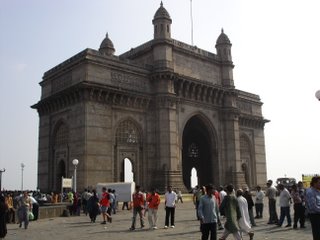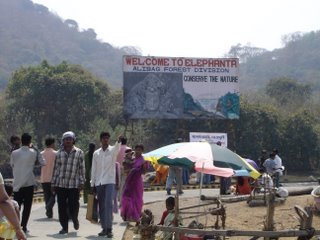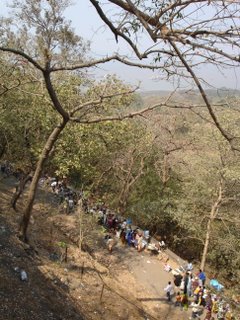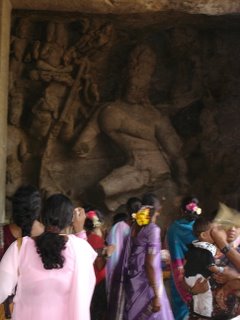Escape
Escape
March 21, 2006
A week ago Wednesday was Holi in India. Holi falls on the day after the full moon in early March and celebrates both harvest and a story from Hindu lore. According to this story a conceited king attempts to prevent his son Prahlada from worshipping Lord Vishnu by attempting to kill him. Even the king’s sister Holika, who legend has it cannot be burned, sits with him in a huge fire to save him. Somehow Prince Prahlada survives while Holika perishes in the flames. In remembrance of this huge bonfires are symbolically burnt on the evening of the full moon (eve of Holi). The next day, which is Holi, people run amok dousing each other with colored powder, called gulal, and water. By noon the play with colors ends and everyone cleans up. Based on conversations with our maid and reading the Mumbai newspapers it is clear that Holi is not that carefree and fun holiday that Bob recalls so fondly from his youth. The Holi of today extends well past noon with people imbibing a marijuana-based alcohol called bang, can be demeaning to women, and doesn’t always stop with good old fashioned fun. In fact my own memory of Holi, as a young child of less than 5 in Ahmedabad, Gujarat is of having someone throw colors on my mother as she opened our door while carrying me. For a child that age, it was frightening even though I am sure that she knew the person. Given all this we did not feel too badly about going out of town on this day. In fact, we decided to take a couple of extra days off (Holi is an official holiday in India) and make a trip to the Maldives.
The Republic of Maldives is a group of 1192 islands clumped into 26 atolls on the equator in the Indian Ocean 650 kms southwest of Sri Lanka. Of these thousand plus islands, only around 200 or so are inhabited and of these 87 are resorts. It was to one of these resort islands that was part of the North Male Atoll that we headed.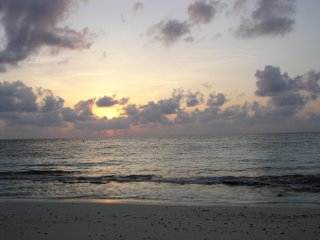
Having been fortunate enough to experience other beach vacations in Hawaii and Mexico, we expected more of the same. Although there are a lot of similarities, there is a certain something about the Maldives that sets it eons apart.
We stayed in a comfortable tropical beachfront accommodation that overlooked coconut trees, between which inviting mesh hammocks were stretched out, and just a few steps beyond these lay a clean crème-coloured sandy beach that stretched into a crisp blue ocean that seemed to extend to infinity and beyond. It was almost as if we had our own private beach and maybe this was the difference. In our stays in Hawaii and Mexico, although the places were also undoubtedly scenic they were overrun with tourists. The entire island that we were on in the Maldives was a single resort and so even though on certain days even though it was completely at capacity we were still afforded the feeling of seclusion.
 Sandrine passed endless hours building sand castles and destroying them and writing her name in the sand with a plastic rake while Bob and I alternated between taking care of Nikhitita and snorkeling, reading, strolling, or just being. The rolling waves frightened Nikhitita and even Sandrine was reluctant to venture into the ocean waters. Wanting the kids to enjoy the exhilarating feeling we had of basking in the sun while being submerged in the water we took them to the swimming pool. Both Sandrine and Nikhitita acquiesced to getting into the swimming pool, which felt like our own, since most of the island’s temporary residents were lounging on their “private” beaches or lagoon decks. In addition to the beachfront villas, lagoon villas were also available and boasted private decks with descending steps that took vacationers directly into the ocean for snorkeling or wading about.
Sandrine passed endless hours building sand castles and destroying them and writing her name in the sand with a plastic rake while Bob and I alternated between taking care of Nikhitita and snorkeling, reading, strolling, or just being. The rolling waves frightened Nikhitita and even Sandrine was reluctant to venture into the ocean waters. Wanting the kids to enjoy the exhilarating feeling we had of basking in the sun while being submerged in the water we took them to the swimming pool. Both Sandrine and Nikhitita acquiesced to getting into the swimming pool, which felt like our own, since most of the island’s temporary residents were lounging on their “private” beaches or lagoon decks. In addition to the beachfront villas, lagoon villas were also available and boasted private decks with descending steps that took vacationers directly into the ocean for snorkeling or wading about.
It was a much needed break away from mobile phones, blackberries, high-speed internet connections, and the pressures of work, school, and managing the home. We did indulge in a little bit of cricket (Bob), Aladdin (Sandrine), and American Idol (me) so I can’t say that we were all that isolated!
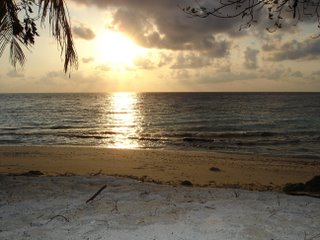 I was struck by how naturally beautiful the Maldives are. During the day, the sandy cream-colored beaches extend to the multi-colored blue ocean which extends to an azure sky speckled with white clouds. And at night the gently rolling waves cover and uncover the sands like a child who takes off and puts on his blanket trying to get the temperature just right. And what sounds at first like the jarring onset of torrential rain from our room are only the undulating waves that crash onto the sands and recede over and over again forming a pleasing symphony for our ears. Even the very air permeates of relaxation and there is only serenity as far as the eye can see. It was not until one of our last mornings in Maldives that reality set in. Nikhitita had gotten up early as she does every morning for her morning doodhoo (milk) and I thought that I would take in the sunrise, seeing as I was already up.
I was struck by how naturally beautiful the Maldives are. During the day, the sandy cream-colored beaches extend to the multi-colored blue ocean which extends to an azure sky speckled with white clouds. And at night the gently rolling waves cover and uncover the sands like a child who takes off and puts on his blanket trying to get the temperature just right. And what sounds at first like the jarring onset of torrential rain from our room are only the undulating waves that crash onto the sands and recede over and over again forming a pleasing symphony for our ears. Even the very air permeates of relaxation and there is only serenity as far as the eye can see. It was not until one of our last mornings in Maldives that reality set in. Nikhitita had gotten up early as she does every morning for her morning doodhoo (milk) and I thought that I would take in the sunrise, seeing as I was already up.
I took a solitary stroll to the jetty, where we had arrived by motorboat a few days earlier, then sauntered lazily on the beach towards the lagoon villas, and then retraced my steps back to “our” hammock. I was surprised to see the flurry of activity by hotel staff at this early hour.
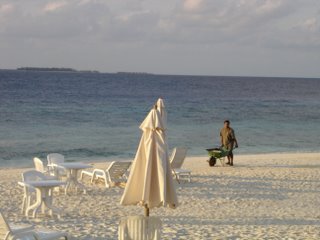 There were at least 2 men (that I could see) with rakes, black plastic bags, and wheelbarrows sweeping the sands in front of our accommodation and those neighboring it.
There were at least 2 men (that I could see) with rakes, black plastic bags, and wheelbarrows sweeping the sands in front of our accommodation and those neighboring it.
As I peered out to the ocean I could see that there were at least 3 more men on the beach itself first sweeping and then collecting the debris and leaves that the wind and tide had unceremoniously deposited on the sands and then carting the pile away by wheelbarrow. The coy sun, which had peeked out tentatively from behind the light billowy clouds, slowly became more brazen. By the time the brilliantly glowing orb shone down with its full intensity, the men had finished their dawn cleaning and the sun luminated beaches scoured so pristine that they seemed to reflect the light back into the inviting sky. I guess that even natural beauty in the Maldives needs a little maintenance.
When we returned back to Mumbai on Sunday and drove back from the airport, the stark reality of pollution, trash strewn about, overcrowded streets, abject poverty set in with a thud. I hadn’t really thought about it before but one of the things that I miss living in Mumbai is natural beauty. We are fortunate to live in the Bay Area, California, which is really beautiful. When I was there I took it for granted until an old friend from the Midwest visited and told me that our subdivision looks like it is set in a resort because of the clear skies, and green mountains that surround it in the distant horizon. I was stunned as we live in just another middle class subdivision. My friend’s comment took me back to when I had first arrived in Northern California nine years ago and gazed out of our rental car in awe at the scenic highway (280) and the homes that were precariously perched on the hillsides. Somehow over the years what I had initially perceived as amazing evolved into the mundane.
Mumbai has many wonderful architectural marvels, a varied population, and by most accounts is a thriving social and economic base for millions. But parks for kids to be kids or adults to simply enjoy a break from the city life are few and far in between and most are also not maintained at the standards that we are used to in the U.S. This is really a shame since even huge metropolitan cities like New York, which has Central Park and San Francisco, which has Golden Gate Park manage to infuse a sense of natural beauty in the midst of the urban sprawl. True, the population of Mumbai dwarfs the other two cities I mentioned but projects like Navi Mumbai (New Bombay) continue to move forward which means that planning for urban growth continues unfettered.
The Maldives taught me that completely natural places to escape to in today’s world are few, far in-between, involve considerable travel, and are probably not completely natural anyway. Like our island getaway where the resort staff meticulously behind the scenes prepare the beaches and grounds for hundred of guests to go back to the “simple things in life”, cities like Mumbai would be well served by having well-kept places for their residents to go to escape. There is no doubt that economically and technologically India and its major cities like Mumbai are positioned well to succeed in the world over the next few generations. However sadly, without some significant aesthetic changes future generations, like today’s generation will continue to go elsewhere to escape.
March 21, 2006
A week ago Wednesday was Holi in India. Holi falls on the day after the full moon in early March and celebrates both harvest and a story from Hindu lore. According to this story a conceited king attempts to prevent his son Prahlada from worshipping Lord Vishnu by attempting to kill him. Even the king’s sister Holika, who legend has it cannot be burned, sits with him in a huge fire to save him. Somehow Prince Prahlada survives while Holika perishes in the flames. In remembrance of this huge bonfires are symbolically burnt on the evening of the full moon (eve of Holi). The next day, which is Holi, people run amok dousing each other with colored powder, called gulal, and water. By noon the play with colors ends and everyone cleans up. Based on conversations with our maid and reading the Mumbai newspapers it is clear that Holi is not that carefree and fun holiday that Bob recalls so fondly from his youth. The Holi of today extends well past noon with people imbibing a marijuana-based alcohol called bang, can be demeaning to women, and doesn’t always stop with good old fashioned fun. In fact my own memory of Holi, as a young child of less than 5 in Ahmedabad, Gujarat is of having someone throw colors on my mother as she opened our door while carrying me. For a child that age, it was frightening even though I am sure that she knew the person. Given all this we did not feel too badly about going out of town on this day. In fact, we decided to take a couple of extra days off (Holi is an official holiday in India) and make a trip to the Maldives.
The Republic of Maldives is a group of 1192 islands clumped into 26 atolls on the equator in the Indian Ocean 650 kms southwest of Sri Lanka. Of these thousand plus islands, only around 200 or so are inhabited and of these 87 are resorts. It was to one of these resort islands that was part of the North Male Atoll that we headed.

Having been fortunate enough to experience other beach vacations in Hawaii and Mexico, we expected more of the same. Although there are a lot of similarities, there is a certain something about the Maldives that sets it eons apart.
We stayed in a comfortable tropical beachfront accommodation that overlooked coconut trees, between which inviting mesh hammocks were stretched out, and just a few steps beyond these lay a clean crème-coloured sandy beach that stretched into a crisp blue ocean that seemed to extend to infinity and beyond. It was almost as if we had our own private beach and maybe this was the difference. In our stays in Hawaii and Mexico, although the places were also undoubtedly scenic they were overrun with tourists. The entire island that we were on in the Maldives was a single resort and so even though on certain days even though it was completely at capacity we were still afforded the feeling of seclusion.
 Sandrine passed endless hours building sand castles and destroying them and writing her name in the sand with a plastic rake while Bob and I alternated between taking care of Nikhitita and snorkeling, reading, strolling, or just being. The rolling waves frightened Nikhitita and even Sandrine was reluctant to venture into the ocean waters. Wanting the kids to enjoy the exhilarating feeling we had of basking in the sun while being submerged in the water we took them to the swimming pool. Both Sandrine and Nikhitita acquiesced to getting into the swimming pool, which felt like our own, since most of the island’s temporary residents were lounging on their “private” beaches or lagoon decks. In addition to the beachfront villas, lagoon villas were also available and boasted private decks with descending steps that took vacationers directly into the ocean for snorkeling or wading about.
Sandrine passed endless hours building sand castles and destroying them and writing her name in the sand with a plastic rake while Bob and I alternated between taking care of Nikhitita and snorkeling, reading, strolling, or just being. The rolling waves frightened Nikhitita and even Sandrine was reluctant to venture into the ocean waters. Wanting the kids to enjoy the exhilarating feeling we had of basking in the sun while being submerged in the water we took them to the swimming pool. Both Sandrine and Nikhitita acquiesced to getting into the swimming pool, which felt like our own, since most of the island’s temporary residents were lounging on their “private” beaches or lagoon decks. In addition to the beachfront villas, lagoon villas were also available and boasted private decks with descending steps that took vacationers directly into the ocean for snorkeling or wading about.It was a much needed break away from mobile phones, blackberries, high-speed internet connections, and the pressures of work, school, and managing the home. We did indulge in a little bit of cricket (Bob), Aladdin (Sandrine), and American Idol (me) so I can’t say that we were all that isolated!
 I was struck by how naturally beautiful the Maldives are. During the day, the sandy cream-colored beaches extend to the multi-colored blue ocean which extends to an azure sky speckled with white clouds. And at night the gently rolling waves cover and uncover the sands like a child who takes off and puts on his blanket trying to get the temperature just right. And what sounds at first like the jarring onset of torrential rain from our room are only the undulating waves that crash onto the sands and recede over and over again forming a pleasing symphony for our ears. Even the very air permeates of relaxation and there is only serenity as far as the eye can see. It was not until one of our last mornings in Maldives that reality set in. Nikhitita had gotten up early as she does every morning for her morning doodhoo (milk) and I thought that I would take in the sunrise, seeing as I was already up.
I was struck by how naturally beautiful the Maldives are. During the day, the sandy cream-colored beaches extend to the multi-colored blue ocean which extends to an azure sky speckled with white clouds. And at night the gently rolling waves cover and uncover the sands like a child who takes off and puts on his blanket trying to get the temperature just right. And what sounds at first like the jarring onset of torrential rain from our room are only the undulating waves that crash onto the sands and recede over and over again forming a pleasing symphony for our ears. Even the very air permeates of relaxation and there is only serenity as far as the eye can see. It was not until one of our last mornings in Maldives that reality set in. Nikhitita had gotten up early as she does every morning for her morning doodhoo (milk) and I thought that I would take in the sunrise, seeing as I was already up.I took a solitary stroll to the jetty, where we had arrived by motorboat a few days earlier, then sauntered lazily on the beach towards the lagoon villas, and then retraced my steps back to “our” hammock. I was surprised to see the flurry of activity by hotel staff at this early hour.

 There were at least 2 men (that I could see) with rakes, black plastic bags, and wheelbarrows sweeping the sands in front of our accommodation and those neighboring it.
There were at least 2 men (that I could see) with rakes, black plastic bags, and wheelbarrows sweeping the sands in front of our accommodation and those neighboring it.As I peered out to the ocean I could see that there were at least 3 more men on the beach itself first sweeping and then collecting the debris and leaves that the wind and tide had unceremoniously deposited on the sands and then carting the pile away by wheelbarrow. The coy sun, which had peeked out tentatively from behind the light billowy clouds, slowly became more brazen. By the time the brilliantly glowing orb shone down with its full intensity, the men had finished their dawn cleaning and the sun luminated beaches scoured so pristine that they seemed to reflect the light back into the inviting sky. I guess that even natural beauty in the Maldives needs a little maintenance.
When we returned back to Mumbai on Sunday and drove back from the airport, the stark reality of pollution, trash strewn about, overcrowded streets, abject poverty set in with a thud. I hadn’t really thought about it before but one of the things that I miss living in Mumbai is natural beauty. We are fortunate to live in the Bay Area, California, which is really beautiful. When I was there I took it for granted until an old friend from the Midwest visited and told me that our subdivision looks like it is set in a resort because of the clear skies, and green mountains that surround it in the distant horizon. I was stunned as we live in just another middle class subdivision. My friend’s comment took me back to when I had first arrived in Northern California nine years ago and gazed out of our rental car in awe at the scenic highway (280) and the homes that were precariously perched on the hillsides. Somehow over the years what I had initially perceived as amazing evolved into the mundane.
Mumbai has many wonderful architectural marvels, a varied population, and by most accounts is a thriving social and economic base for millions. But parks for kids to be kids or adults to simply enjoy a break from the city life are few and far in between and most are also not maintained at the standards that we are used to in the U.S. This is really a shame since even huge metropolitan cities like New York, which has Central Park and San Francisco, which has Golden Gate Park manage to infuse a sense of natural beauty in the midst of the urban sprawl. True, the population of Mumbai dwarfs the other two cities I mentioned but projects like Navi Mumbai (New Bombay) continue to move forward which means that planning for urban growth continues unfettered.
The Maldives taught me that completely natural places to escape to in today’s world are few, far in-between, involve considerable travel, and are probably not completely natural anyway. Like our island getaway where the resort staff meticulously behind the scenes prepare the beaches and grounds for hundred of guests to go back to the “simple things in life”, cities like Mumbai would be well served by having well-kept places for their residents to go to escape. There is no doubt that economically and technologically India and its major cities like Mumbai are positioned well to succeed in the world over the next few generations. However sadly, without some significant aesthetic changes future generations, like today’s generation will continue to go elsewhere to escape.

